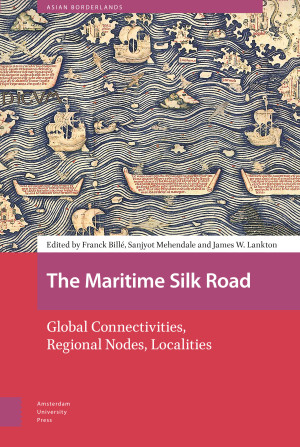The Maritime Silk Road foregrounds the numerous networks that have been woven across oceanic geographies, tying world regions together often far more extensively than land-based routes. On the strength of the new data which has emerged in the last two decades in the form of archaeological findings, as well as new techniques such as GIS modelling, the authors collectively demonstrate the existence of a very early global maritime trade. From architecture to cuisine, and language to clothing, evidence points to early connections both within Asia and between Asia and other continents—well before European explorations of the Global South. The human stories presented here offer insights into both the extent and limits of this global exchange, showing how goods and people travelled vast distances, how they were embedded in regional networks, and how local cultures were shaped as a result.
Title: The Maritime Silk Road: Global Connectivities, Regional Nodes, Localities
Editors: Franck BilléSanjyot MehendaleJames Lankton
ISBN: 9789048552429
Format: eBook PDF
Number of pages: 284
Language: English
Publication date: 01 – 10 – 2022
Open Access: Download on Open Access Platform
Series: Asian Borderlands
Categories: Anthropology, Art and Material Culture, History
Discipline: Asian Studies
Also available as Hardback – € 124,00
Table of Contents
Illustrations
Acknowledgments
(Franck Billé, Sanjyot Mehendale, and James W. Lankton) Introduction
Globalities
1. (Eivind Heldaas Seland) Spaces, Places and Things: The Spatial Dimension of Early Indian Ocean Exchange
2. (Hyunhee Park) Open Space and Flexible Borders: Theorizing Maritime Space through Premodern Sino-Islamic Connections
3. (James W. Lankton) From Regional to Global: Early Glass and the Development of the Maritime Silk Road
Regional Nodes
4. (Jun Kimura) Archaeological evidence of shipping and shipbuilding along the Maritime Silk Road
5. (Ariane De Saxcé) Networks and cultural mapping of South Asian maritime trade
6. (Shadreck Chirikure) Southern Africa and the Indian Ocean World: Relocating Agency From “Center” to “Periphery,” From the Maritime Silk Road to the Maritime Ivory Route
Localities
7. (John N. Miksic) Chinese Ceramics on the Maritime Silk Road The Importance of Context
8. (Derek Heng) Urban Demographics along the Maritime Asian Silk Road: Archaeological Small Finds and Settlement Patterns at Pre-Modern Port-Settlements of the Malay Region
9. (Osmund Bopearachchi) Indian Ocean Trade through Buddhist Iconographies
Contributors
Index

EDITORS
Franck Billé
Franck Billé is a cultural anthropologist based at the University of California, Berkeley, where he is program director for the Tang Center for Silk Road Studies. He is the author of Sinophobia (Hawaii, 2015), coauthor of On the Edge (Harvard, 2021), editor of Voluminous States (Duke, 2020), and coeditor of Yellow Perils (Hawaii, 2019) and Frontier Encounters (Open Book, 2012). He is currently finalizing his latest book, Somatic States: On Cartography, Geobodies, Bodily Integrity (Duke University Press). More information about his current research is available on his website: www.franckbille.com.
Sanjyot Mehendale
Sanjyot Mehendale is Chair of the P.Y. and Kinmay W. Tang Center for Silk Road Studies and Vice Chair of the Center for Buddhist Studies at UC Berkeley. Her main research concerns is a focus on the Kushan period, in particular on trade and cultural exchange and the relationship between Kushan kingship and Buddhist institutions. A recipient of a National Endowment for the Humanities Fellowship, she has developed, in collaboration with the Electronic Cultural Atlas Initiative, a digital archive of the Begram ivory and bone carvings, which were once housed in the National Museum in Kabul, Afghanistan (www.ecai.org/begramweb=). The author of several articles on Silk Roads art and archaeology, she is the co-editor of Central Asia and the Caucasus: Transnationalism and Diaspora (Routledge, 2005).
James Lankton
James W. Lankton is currently a Senior Research Associate at UCL Institute of Archaeology in London and has been a Visiting Scholar at the Tang Center for Silk Road Studies, UC Berkeley. For the past twenty years James has focused on the interpretation of chemical analyses of early glass found both East and West, with recent projects on glass from South and Southeast Asia and Korea in the late 1st c. BCE to the 6th c. CE, and Egypt and the Mediterranean basin from the Late Bronze Age.